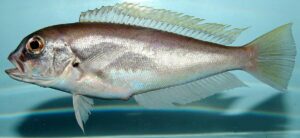Tilefish are a fascinating and colorful species of marine fish found in deep waters along continental shelves. Known for their vibrant hues and firm, flavorful flesh, tilefish have become a sought-after catch for anglers and a popular ingredient in fine dining. This comprehensive guide delves into the various aspects of tilefish, including their species classification, habitat, behavior, culinary uses, nutritional benefits, fishing techniques, conservation status, and ecological importance.
Species Classification and Identification

Tilefish belong to the Malacanthidae family, which includes two subfamilies: Branchiosteginae and Malacanthinae. They are distributed across several genera, with the most notable being:
- Blueline Tilefish (Caulolatilus microps): Characterized by a blue line running from its eyes to the base of its dorsal fin, this species is found in the western Atlantic Ocean.
- Golden Tilefish (Lopholatilus chamaeleonticeps): Known for its vibrant gold and blue coloration, this species is native to the eastern coast of the United States and is often referred to as the “clown of the sea.”
- Sand Tilefish (Malacanthus plumieri): Distinguished by its elongated body and sandy coloration, this species inhabits the western Atlantic and Caribbean regions.
Physical Characteristics

Tilefish are known for their unique and striking appearance, which varies significantly between species:
- Size: Tilefish can range from 12 to 48 inches (30 to 122 cm) in length, with some species weighing up to 80 pounds (36 kg).
- Coloration: These fish are often brightly colored, with patterns of blue, yellow, and gold. The golden tilefish, in particular, displays a dazzling array of colors, with a shimmering golden body and iridescent blue markings.
- Body Shape: Tilefish have a robust, elongated body with a large head and a continuous dorsal fin. Their scales are small and tightly packed, contributing to their streamlined appearance.
Distinguishing Features
- Dorsal Fin: Tilefish have a long dorsal fin that runs along their back, often with distinctive color markings.
- Tail: Their tails are typically forked, aiding in swift and agile swimming.
Habitat and Distribution
Tilefish are found in deep waters along continental shelves and slopes, often inhabiting burrows they dig into sandy or muddy substrates. They are primarily distributed in the Atlantic and Pacific Oceans.
Preferred Environments
Tilefish prefer deep-water environments, typically found at depths ranging from 200 to 1,500 feet (61 to 457 meters). They are often associated with areas that have:
- Substrates: Sandy or muddy bottoms where they can construct burrows for shelter and spawning.
- Temperature: Tilefish thrive in cooler waters, generally between 50°F and 70°F (10°C to 21°C).
Distribution
- Atlantic Ocean: Tilefish are commonly found along the eastern coast of the United States, from New England to the Gulf of Mexico.
- Pacific Ocean: Some species are found in the western Pacific, particularly around coral reefs and sandy bottoms.
Behavior and Feeding Habits
Tilefish are solitary creatures known for their burrowing behavior and diverse diet. They play a unique role in the marine ecosystem as both predators and engineers of their environment.
Feeding Strategies
Tilefish are opportunistic feeders, consuming a variety of prey depending on availability and habitat:
- Primary Diet: Their diet consists mainly of crustaceans such as crabs, shrimp, and lobsters, as well as mollusks like clams and snails.
- Other Prey: Tilefish also eat small fish and benthic invertebrates, using their strong jaws to crush shells and exoskeletons.
Burrowing Behavior
- Burrow Construction: Tilefish construct elaborate burrows in the ocean floor, which provide shelter from predators and harsh environmental conditions. These burrows can be quite large, with intricate tunnel systems.
- Social Behavior: While generally solitary, tilefish may share their burrows with other marine organisms, creating a unique microhabitat.
Reproduction and Lifecycle
Tilefish have a relatively long lifespan, often living up to 35 years. Their reproductive behavior includes:
- Spawning Season: Spawning typically occurs in the spring and summer months, though timing can vary by region and species.
- Spawning Habitats: Tilefish spawn in open water, where fertilized eggs develop into planktonic larvae that drift with ocean currents before settling on the ocean floor.
- Juvenile Development: Young tilefish grow rapidly, reaching maturity within a few years and establishing their burrows.
Culinary Uses and Nutritional Benefits

Tilefish are highly valued in the culinary world for their firm, white flesh, and mild, sweet flavor. Their versatility in the kitchen makes them a popular choice for various dishes.
Popular Dishes
- Grilled Tilefish: Seasoned with herbs and spices, grilled tilefish offers a rich flavor and tender texture, often paired with lemon and garlic.
- Baked Tilefish: Baked with butter, herbs, and vegetables, tilefish makes a hearty and flavorful dish.
- Tilefish Tacos: Seared tilefish combined with fresh salsa and wrapped in tortillas creates a delicious and healthy meal.
- Tilefish Ceviche: Marinated in citrus juice with onions, peppers, and cilantro, tilefish ceviche provides a refreshing and zesty flavor.
Nutritional Profile
Tilefish offer several nutritional benefits, making them a healthy addition to the diet:
- Protein: High in lean protein, tilefish supports muscle growth and repair.
- Omega-3 Fatty Acids: These healthy fats promote heart health, reduce inflammation, and support brain function.
- Vitamins and Minerals: Tilefish are a good source of vitamins B6, B12, and D, as well as minerals like selenium and phosphorus, contributing to overall health and well-being.
Mercury Consideration
Tilefish can have higher mercury levels compared to other fish, so it is advisable to consume them in moderation, particularly for pregnant women and young children. Choosing smaller, younger fish can help reduce mercury exposure.
Fishing Techniques and Tips
Fishing for tilefish is a popular and rewarding activity, particularly in regions where they are abundant. Here are some effective techniques and tips for catching tilefish:
Deep Sea Fishing
Tilefish are typically targeted through deep-sea fishing methods, as they inhabit deeper waters beyond the reach of most standard fishing techniques.
- Equipment: Heavy-duty rods and reels with strong lines are necessary for deep-sea fishing, as tilefish can be found at significant depths.
- Bait: Common baits include squid, cut fish, and shrimp, which are dropped to the ocean floor using weighted rigs.
- Technique: Fishing over known tilefish habitats, such as sandy bottoms and slopes, increases the chances of a successful catch.
Bottom Fishing
Bottom fishing involves targeting tilefish near the ocean floor using specialized rigs designed to reach their deep habitats.
- Equipment: Use bottom rigs with multiple hooks and heavy sinkers to keep the bait near the substrate.
- Bait: Natural baits like squid, clams, and crab are effective in attracting tilefish.
- Location: Focus on areas with sandy or muddy bottoms where tilefish are likely to burrow.
Tips for Success
- Location: Look for structures like ledges, reefs, and slopes, where tilefish are often found.
- Timing: Early morning and late afternoon are prime times for tilefish fishing, as they are more active during these periods.
- Patience: Tilefish fishing requires patience and persistence, as they can be elusive and challenging to catch.
Conservation Status and Ecological Importance
Tilefish are generally not considered endangered, but some populations face threats from overfishing and habitat degradation. Conservation efforts are essential to ensure their populations remain stable and sustainable.
Ecological Role
Tilefish play a crucial role in marine ecosystems as both predators and prey:
- Predators: By consuming crustaceans and benthic invertebrates, tilefish help regulate prey populations and contribute to the balance of the oceanic food web.
- Prey: They serve as a food source for larger predators, including sharks and large fish.
Conservation Efforts
Efforts to conserve tilefish populations include:
- Fishing Regulations: Implementing size and catch limits to prevent overfishing and ensure sustainable populations.
- Habitat Protection: Preserving critical habitats, such as spawning and feeding areas, from pollution and development.
- Research and Monitoring: Conducting studies to better understand tilefish populations, ecology, and potential threats, leading to more effective management strategies.
Conclusion
Tilefish are a remarkable species with significant culinary, recreational, and ecological value. Their unique appearance, delicious flavor, and role in marine ecosystems make them a valuable resource that requires careful management and conservation. By understanding and appreciating the unique characteristics of tilefish, we can enjoy their benefits while contributing to their preservation for future generations. Whether you’re an angler seeking an exciting catch or a chef exploring new flavors, tilefish offers a rich and rewarding experience that embodies the spirit of the sea.

